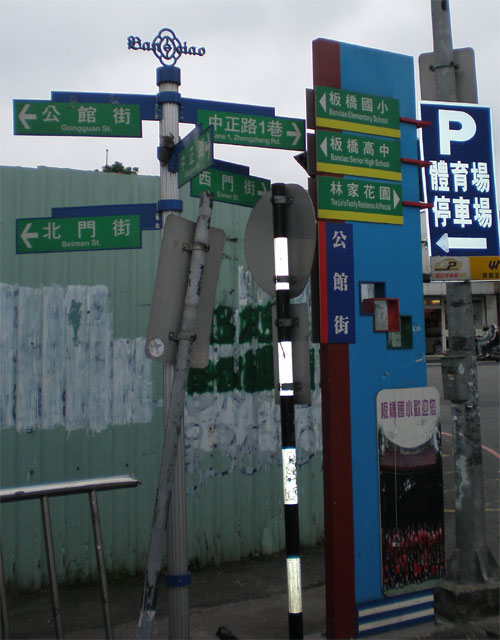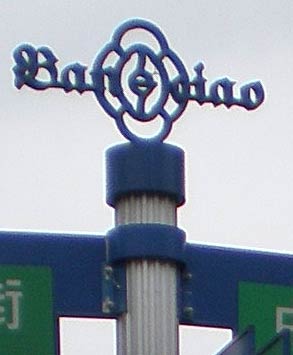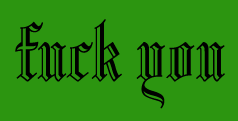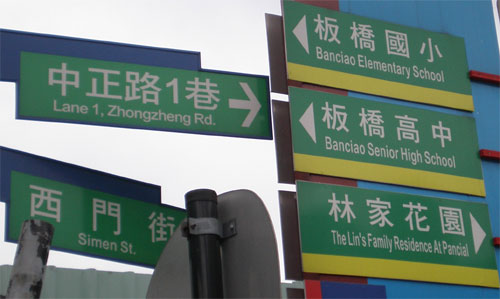Here’s an example of the mixing of romanization systems and addition of errors that used to be common in Taipei before the city switched to Hanyu Pinyin. These signs are on a corner in Banqiao, Taipei County, not far from Banqiao City Hall.
First, let’s set the scene. We have two types of signs, both with a mix of romanization and English. One set of signs gives street names; the other points toward places of possible interest.

The blue-panel signage on the right represents something introduced during the term of the previous mayor, a member of the Democratic Progressive Party. And since the DPP backs Tongyong Pinyin for Mandarin, that’s the romanization system used most of the time on such signs. A number of the photos on these signs feature the previous mayor, who had relatively little recognition among the public since he had succeeded someone else’s term rather than being elected to his own. He put his photo on all sorts of things. But he failed to be elected to the city’s top spot. His challenger, the current mayor of Banqiao, spreads her name recognition by having her recycling speech broadcast from the city’s trash trucks.
 OK, now note the cap on the signpost. It reads “Ban ciao” in black letter. Although I spotted several of these today, I’d never seen any before, which would mean it’s very likely that a KMT-led city administration under a KMT-led county government is putting up new signs in Tongyong Pinyin, a romanization system the Kuomintang (Guomindang) opposes. (The KMT used to oppose Hanyu Pinyin as well, which is how Taiwan ended up with MPS2, the Tongyong Pinyin of the 1980s.) Similarly, Banqiao has relatively new signs in prominent places around the city that read (in a particularly clumsy script face) “Bravo Banciao.” (What exactly about Banqiao is worthy of such a cheer is not stated.) Even though the city administration is under the mistaken impression that it must use Tongyong (and it does suffer from this idea), that doesn’t mean it has to go around putting up new signage in this.
OK, now note the cap on the signpost. It reads “Ban ciao” in black letter. Although I spotted several of these today, I’d never seen any before, which would mean it’s very likely that a KMT-led city administration under a KMT-led county government is putting up new signs in Tongyong Pinyin, a romanization system the Kuomintang (Guomindang) opposes. (The KMT used to oppose Hanyu Pinyin as well, which is how Taiwan ended up with MPS2, the Tongyong Pinyin of the 1980s.) Similarly, Banqiao has relatively new signs in prominent places around the city that read (in a particularly clumsy script face) “Bravo Banciao.” (What exactly about Banqiao is worthy of such a cheer is not stated.) Even though the city administration is under the mistaken impression that it must use Tongyong (and it does suffer from this idea), that doesn’t mean it has to go around putting up new signage in this.
To get back to the cap, the likely story is that the transportation department had some leftover money in its budget which had to be spent lest the following year’s budget be cut; but rather than spend it on fixing errors, which would involve study and actual work, people decided to make something that the boss thinks would look cool.
I wonder, though, how many Taiwanese would even recognize this reads “Banciao” unless they had it specifically pointed out to them. A few months ago I spotted an innocent-looking teenager shopping with her mother. The girl was wearing a shirt with the following text:

Although it’s almost certain she would know both English words and understand their meaning together, I think it extremely unlikely she knew what words were on her shirt.
OK, let’s have a closer look at the signs themselves.

Here we have
- “Zhongzheng” (Hanyu Pinyin)
- “Simen” and “Banciao” (Tongyong Pinyin for what would be “Ximen” and “Banqiao” in Hanyu Pinyin)
- “Panchial” (bastardized Wade-Giles of “Panchiao” plus a typo, for what would be “Banqiao” in Hanyu Pinyin)
And then there’s the matter of “The Lin’s Family Residence At Panchail,” which would be much better written simply “Lin Family Residence” or by the most commonly used English name “Lin Family Gardens.”
So that’s three romanization systems, a typo, and clumsy English on official signage at just one corner — to say nothing of how relatively small the alphabetic text is. And there’s no solution in sight.

What I hate the most about “Banciao” is that it reads very
effeminately (???) when we read it using our Hanyu Pinyin habits.
I mean I’m having enough problems already when the ???? callers
all think I am a misses. All the more reason why I will be waiting for
Tongyong perpetrator Yu B.Q. at heaven’s gates with a crowbar.
P.S., yes many KMT local government seem to use T*ngyong unwittingly.
But one cannot blame them because they can’t tell the difference.
Blame that on the education system…
It is just the whole lack of care that dismays me. Romanisation shouldn’t be that difficult. Here is a country that has built the high speed rail and is a world leader in hi-tech manufacturing but it can’t do something as simple as get the right spelling on a sign.
I think Dan makes a good point about the education system. Most people in Taiwan are just confused by the whole thing as a result of having had various official systems over the years. Romanisation should be included in the school curriculum as a basic component of literacy.
Can anyone tell me if the Chinese-character street signs in London’s Chinatown are correct, or no better than the romanized signs we see around Taiwan?
I’ve never been to London and don’t know anything about the signage there. I looked around on the Web and found that Wikipedia has a photo of a street sign in London’s Chinatown.
The sign gives ??? (Juélù Ji?) for Gerrard Street and ??? (X?m?n Shì) for Westminster. “Juelu” doesn’t appear to be a phonetic rendering of the English — not even in Cantonese. And it’s not a straight translation either, unless “Gerrard” has meanings I don’t know about. Juelu is a Literary Sinitic term meaning “rank and emolument of nobility.” Further reinforcing that this is something of a highfalutin name, ? and ? are relatively uncommon, both being down around the 3,000 mark of most-used characters, and so not exactly ideal for popular signage. Still, it’s probably safe to assume that members of the local community came up with the name rather than having it imposed by some white London official with an English-Chinese dictionary.
As for Ximin Shi, this is clearly a mix of meaning and sound translation, with xi the “west” of Westminster, min a phonetic element (Westminster), and shi as both approximately phonetic (-ster) and semantic (shi = “city”).
I’m working on a post now about signage in San Francisco. The Chinatown there was established long before that of London.